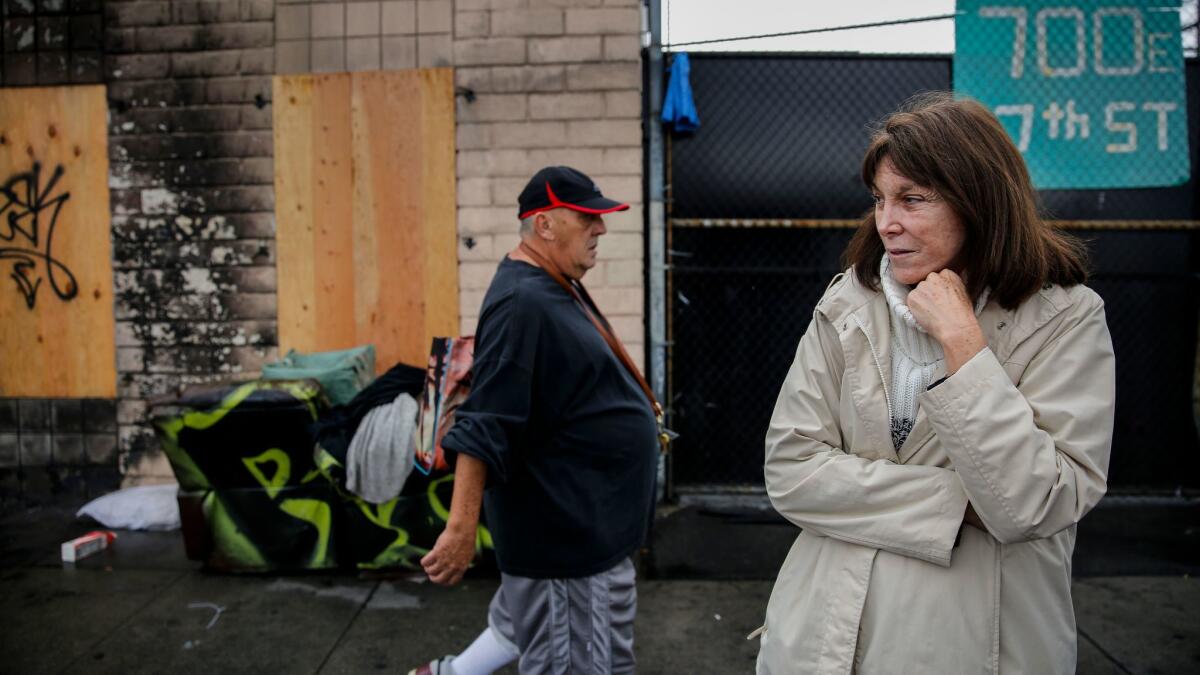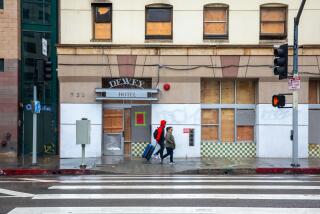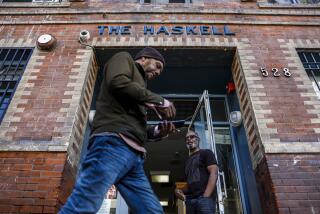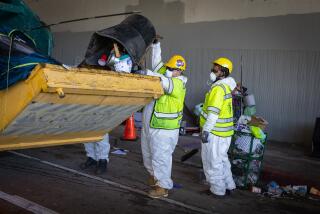Downtown residents say City Hall is ignoring fires on skid row while cracking down in Bel-Air
After authorities determined that last month’s Skirball fire in Bel-Air was caused by a cooking fire at a homeless encampment, Mayor Eric Garcetti and fire officials unveiled a plan to clear tent clusters in hillside areas.
But the announcement frustrated downtown business leaders, who say that fires on or near skid row are a daily problem that City Hall has not adequately addressed.
“The city did the right thing after the Skirball fire,” Estela Lopez, executive director of Downtown Industrial Business Improvement District, said at a neighborhood council meeting earlier this month. “But human life and property should have the same value [everywhere].”
Homeless encampment fires are endangering human lives and businesses in skid row, community leaders say. The fires start when homeless residents cook, try to keep warm or use drugs. Other blazes are intentionally set.
In December, a fire engulfed a sidewalk tent on skid row and quickly spread to a seafood warehouse. The nighttime blaze, captured on video, destroyed a homeless camp and caused an estimated $25,000 in damage to the warehouse.
According to the Downtown Industrial Business Improvement District, there were 60 fires last year in the skid row neighborhood. The Fire Department’s numbers are even higher, with three to five fires reported a day in or near skid row — a mix of trash, encampment and building fires, according to LAFD Battalion Chief Mike Castillo.
After hearing from Lopez and discussing the fires, the Downtown L.A. Neighborhood Council voted earlier this month to ask Garcetti and Los Angeles Fire Chief Ralph Terrazas for “appropriate funds and manpower” to deal with the fire risk.
Lopez said she has met twice with Garcetti’s office in the last two years to discuss skid row fires, but hasn’t seen additional resources from the Fire Department.
Skid row tents rest against buildings or are tied to warehouses, creating potentially dangerous fire conditions, Lopez said. The tents sit closely against one another, and in some cases, near piles of trash.
More than 4,600 homeless people live on skid row, a 50-block neighborhood that is also home to the downtown industrial district. Warehouses loom over sidewalks filled with rows of tents, as food wholesalers and distributors work in an area that police say is rife with human trafficking and drug dealing.
Garcetti spokesman Alex Comisar said that after last month’s Skirball and Creek fires, the mayor formed a task force to reduce the fire risks posed by encampments citywide. “The task force, which has already met twice, is designed to address fire prevention across the city, including on skid row,” Comisar said.
“I understand the argument that you’re suddenly paying attention to the hillside encampments,” said Castillo, supervisor for the LAFD’s arson counterterrorism section. “But we take every homeless encampment seriously.”
There have been 75 fires involving buildings in the skid row area in the last five years, he said. Additionally, the overall number of neighborhood fires has increased as the homeless population has grown, Castillo said.
“It’s gotten worse,” he said. “I’ve been on the job for 34 years, and I’ve worked primarily in the downtown area and I’ve seen an increase in these types of fires.”
Trespassing laws make it easier to remove hillside encampments on private land, but court rulings and city laws complicate efforts to clear sidewalk tents, Castillo said.
Te, a homeless man who lives in an encampment on 7th Street, near the site of the December fire, pointed to a waxy hole in a laundry basket caused by an overturned candle.
“People light fires to stay warm, people light candles to stay warm,” said Te, who declined to give his last name. “There’s also drug activity, people being paranoid and burning stuff up.”

Lisa Rich, who owns the warehouse that caught fire in December, led a reporter around her charred building last week. Part of the warehouse smelled like smoke, and electricity was still out in some rooms.
“I pay a city business tax, I pay property taxes, I shouldn’t have to pay for this,” she said.
Ernie Doizaki, who runs a food storage and distribution business for cruise ships, said his Kohler Street building has been damaged by two encampment fires in the last 18 months. There are still burn marks on his building.
“You look at the news reports with humor,” he said. “The city is going after all these encampments in mountain areas, but we’ve been reporting these fires for the past four years.”
The Union Rescue Mission on San Pedro Street was charred last summer after a fire was intentionally set, said Andy Bales, the mission’s president. He said an angry woman lit a pile of clothing and debris to start the blaze.
Bales, who has been critical of city officials for not offering temporary housing, said the skid row fires are the result of leaving “such a vast amount of people on the streets.”
Harvey Monastirsky’s beer warehouse on Gladys Avenue was damaged in a 2012 fire, which started when a man grew angry during an encounter with a prostitute and torched a nearby tent.
Monastirsky said his insurance company dropped him after he filed the claim. When rebuilding, Monastirsky said he used aluminum siding to prevent damage from any future blazes.
Still, the fire risk remains. A security camera on Monastirsky’s building captured the glow of flames Wednesday night and showed a man cleaning a fire pit the next morning.
Twitter: @dakotacdsmith
More to Read
Start your day right
Sign up for Essential California for news, features and recommendations from the L.A. Times and beyond in your inbox six days a week.
You may occasionally receive promotional content from the Los Angeles Times.







